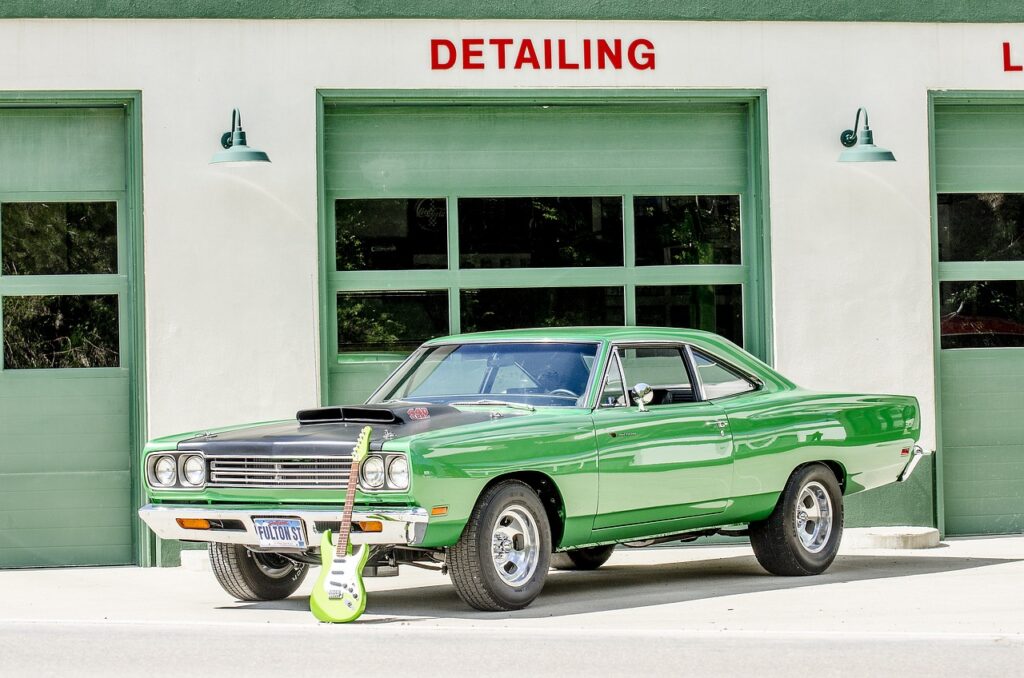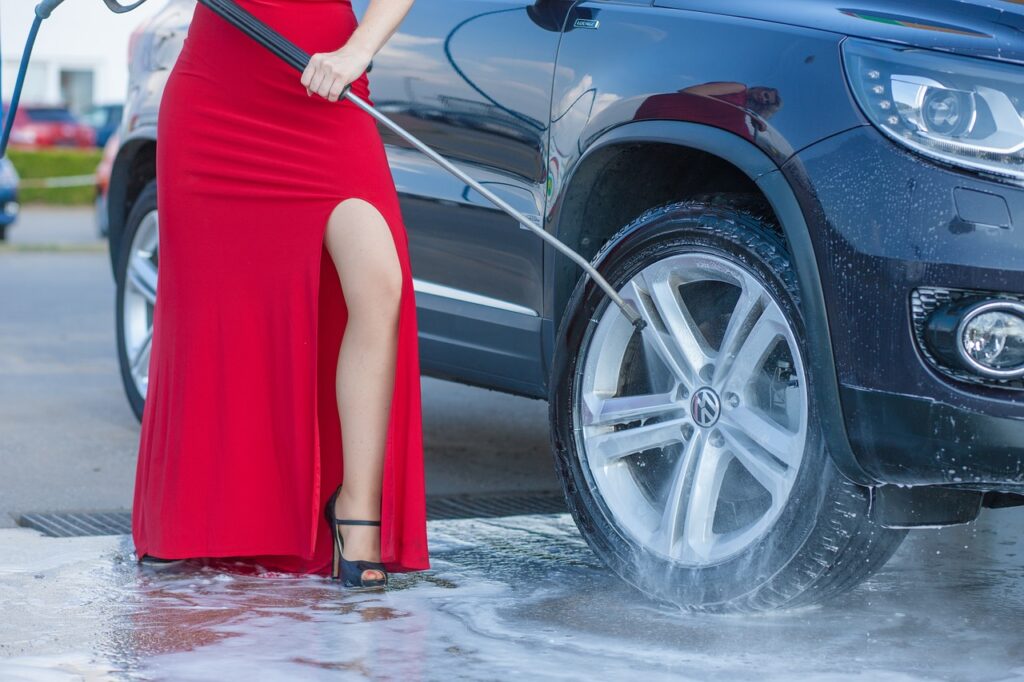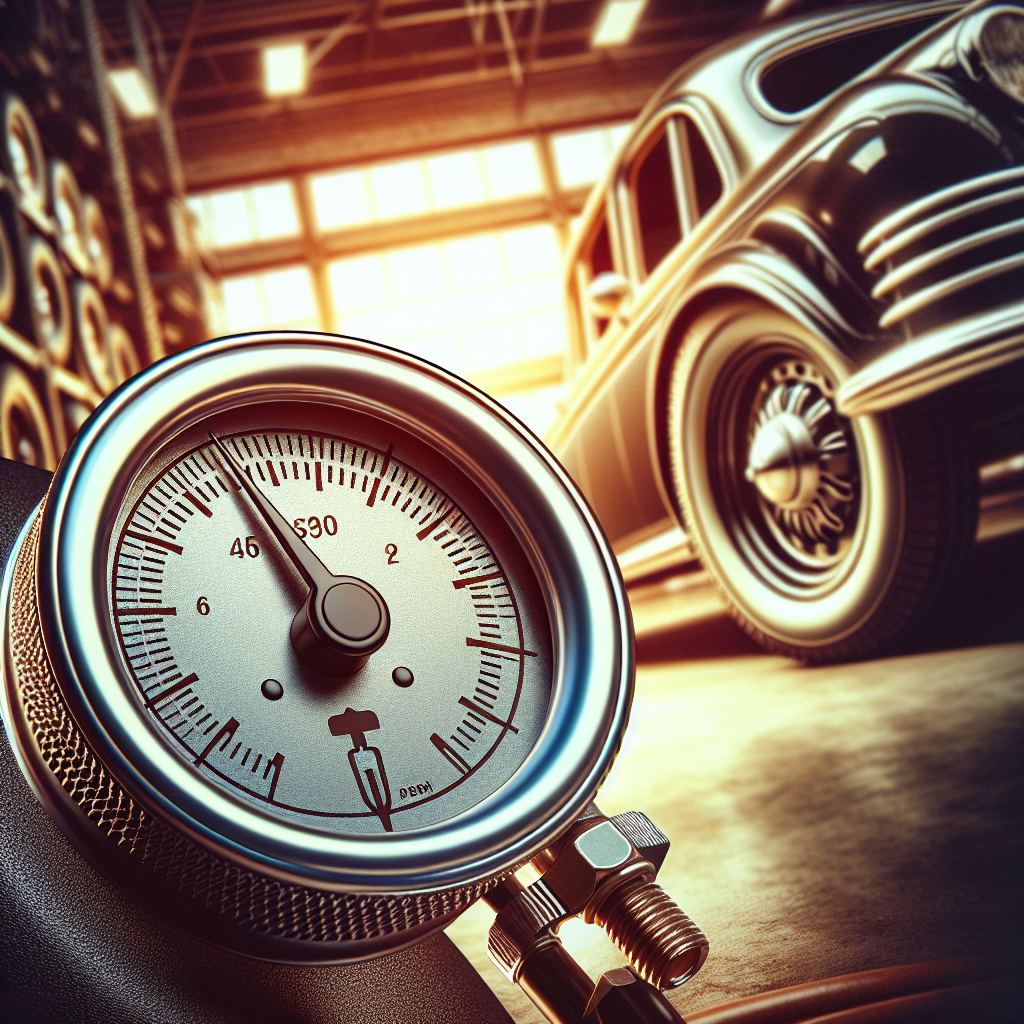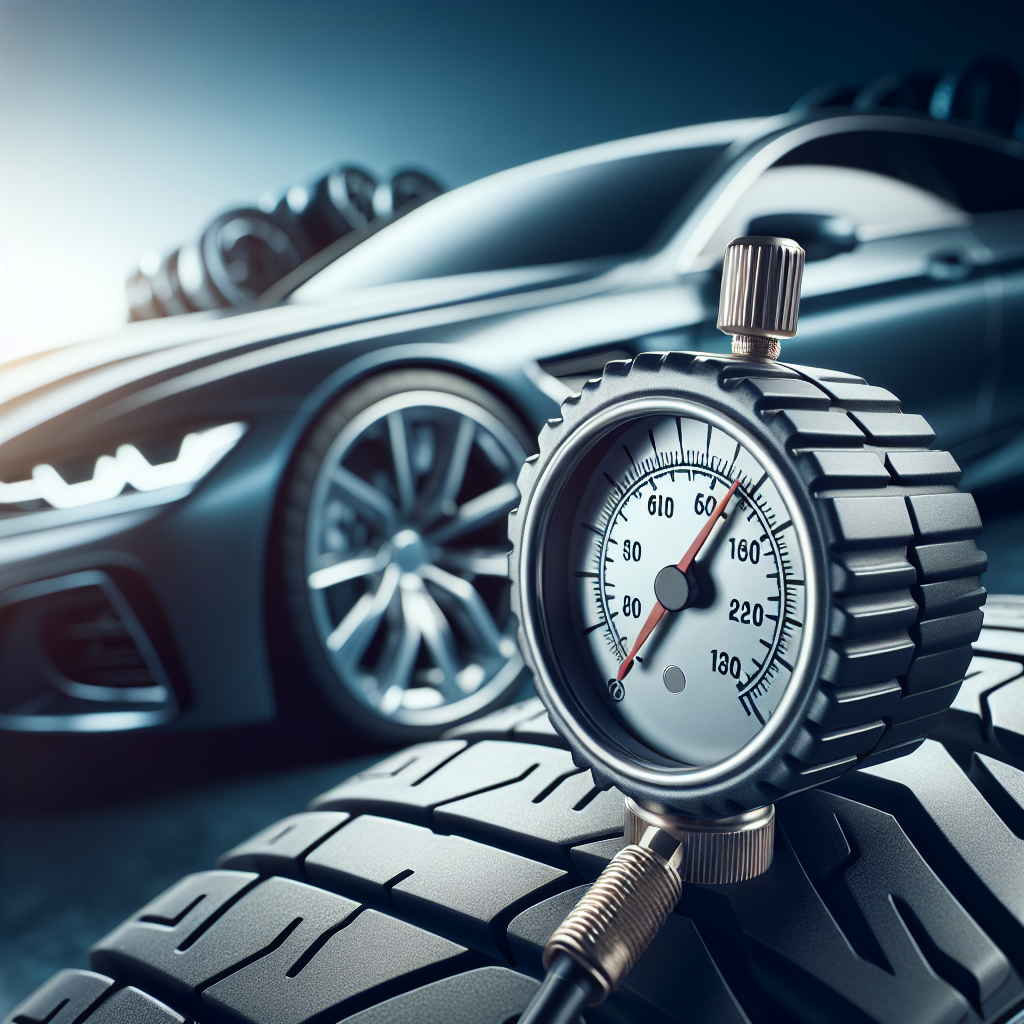Have you ever wondered about the importance of checking and maintaining tire pressure? It may be a seemingly small detail, but it plays a crucial role in ensuring a safe and efficient driving experience. In this article, we will explore the simple steps and tools you need to effectively monitor and maintain tire pressure. By understanding the significance of this routine task, you can prolong the life of your tires, enhance fuel efficiency, and, most importantly, ensure the safety of yourself and your passengers. So, let’s dive into the world of tire pressure and discover how easy it is to keep your wheels rolling smoothly.

Importance of Checking and Maintaining Tire Pressure
Ensuring that your tires are properly inflated is essential for a safe and smooth driving experience. Proper tire pressure not only prevents accidents and improves road safety but also ensures optimal fuel efficiency and prolongs the lifespan of your tires. By taking the time to regularly check and maintain tire pressure, you can save yourself from potential mishaps and costly repairs down the road.
Prevents accidents and improves road safety
One of the primary reasons for regularly checking tire pressure is to prevent accidents and enhance road safety. Improperly inflated tires can lead to a variety of problems such as decreased traction, increased stopping distance, and poor handling. When your tires are underinflated, they have more contact with the road surface, which can result in overheating and tire failure. On the other hand, overinflated tires can cause a bumpy and unstable ride, making it harder to control your vehicle. By maintaining the correct tire pressure, you can significantly reduce the risk of accidents and ensure a safer drive for yourself and others on the road.
Ensures optimal fuel efficiency
Properly inflated tires help optimize your vehicle’s fuel efficiency. When your tires are underinflated, they create more rolling resistance, which requires your engine to work harder and consume more fuel. This not only leads to increased fuel costs but also negatively impacts the environment by contributing to higher emissions. On the other hand, overinflated tires can also reduce fuel efficiency by causing uneven wear on the tread, which can result in decreased traction and increased fuel consumption. By checking and maintaining your tire pressure, you can ensure that your vehicle is operating at its peak efficiency, saving you money and reducing your carbon footprint.
Prolongs tire lifespan
Regularly checking and maintaining tire pressure can significantly extend the lifespan of your tires. Underinflated tires cause the sidewalls to flex excessively, leading to increased heat buildup and accelerated wear. In contrast, overinflated tires put additional stress on the center of the tread, causing it to wear out quickly. By keeping your tires at the recommended pressure, you can distribute the load evenly across the entire tread, resulting in more even wear and a longer tire lifespan. This not only saves you money on frequent tire replacements but also ensures that your tires perform optimally in terms of traction and handling.
Equipment Needed for Checking Tire Pressure
Before you begin checking your tire pressure, there are a few tools that you will need to have on hand. These include a tire pressure gauge, an air compressor or pump, and a tire inflation chuck.
Tire pressure gauge
A tire pressure gauge is a handheld device that allows you to measure the air pressure inside your tires accurately. There are various types of tire pressure gauges available, including digital gauges and analog gauges. Digital gauges often provide a more precise reading, while analog gauges can be easier to read in certain lighting conditions. It’s important to choose a gauge that is compatible with the valve stems on your vehicle’s tires.
Air compressor or pump
To adjust your tire pressure, you will need an air compressor or pump. These tools are designed to provide a steady flow of air into your tires to reach the desired pressure level. It’s important to choose an air compressor or pump that is suitable for the size and type of tires you have.
Tire inflation chuck
A tire inflation chuck is a device that attaches to the end of your air compressor or pump’s hose and connects to the valve stem on your tires. It allows for a secure connection, ensuring that air is directed into the tire without any leaks. Some tire inflation chucks also include a pressure release valve, which allows you to release excess air if necessary.
Having these tools readily available will make the process of checking and maintaining your tire pressure much simpler and more efficient.
Step-by-Step Guide to Checking Tire Pressure
Now that you have the necessary equipment, let’s walk through the step-by-step process of checking your tire pressure.
1. Park your vehicle on a level surface
Before you begin checking your tire pressure, it’s important to park your vehicle on a level surface. This ensures an accurate reading and allows for safe and easy access to the tires.
2. Locate the recommended tire pressure
The recommended tire pressure for your vehicle can typically be found in the owner’s manual, on a sticker inside the driver’s side door jamb, or on the sidewall of the tire itself. It’s essential to use the recommended pressure specific to your vehicle, as different vehicles and tire sizes may have different pressure requirements.
3. Remove the valve cap
Before attaching the tire pressure gauge, remove the valve cap from the valve stem. The valve cap helps to keep out dust and debris and should be kept in a safe place during the checking process to avoid misplacing it.
4. Attach the tire pressure gauge
With the valve cap removed, attach the tire pressure gauge to the valve stem by firmly pressing it onto the stem until a hissing sound is heard. This indicates that the gauge is properly connected, allowing for an accurate reading.
5. Read the pressure reading
Once the tire pressure gauge is connected, it will display a reading of the air pressure inside the tire. Take note of the reading and proceed to the next step.
6. Compare with the recommended pressure
Compare the reading on the tire pressure gauge with the recommended pressure for your vehicle. If the reading is lower than the recommended pressure, the tire is underinflated. If the reading is higher than the recommended pressure, the tire is overinflated. If the reading matches the recommended pressure, the tire is properly inflated.
7. Inflate or deflate the tire if necessary
If the tire pressure is too low, you will need to add air using an air compressor or pump. Attach the tire inflation chuck to the valve stem and inflate the tire to the recommended pressure. If the tire pressure is too high, you can release air by pressing the pressure release valve on the tire inflation chuck while securely attached to the valve stem.
8. Recheck the pressure
After inflating or deflating the tire, recheck the pressure using the tire pressure gauge to ensure that it matches the recommended pressure. Repeat this process for each tire on your vehicle, including the spare tire.
By following these steps, you can easily and effectively check your tire pressure and make any necessary adjustments to ensure that your tires are properly inflated.
How Often Should Tire Pressure be Checked?
Regularly checking tire pressure is crucial for maintaining optimal performance and safety. Here are some guidelines on when and how often you should check your tire pressure:
At least once a month
To maintain proper tire pressure, it is recommended to check your tire pressure at least once a month. This allows you to catch any gradual changes in pressure and make adjustments accordingly. Regular monthly checks can help keep your tires in good condition and prevent any potential issues from arising.
Before long trips or road journeys
Before embarking on any long trips or road journeys, it is essential to check your tire pressure. Extended periods of driving can increase tire temperature, causing the air inside the tires to expand and potentially lead to overinflation. By checking your tire pressure before setting off, you can ensure a safe and smooth ride throughout your journey.
After significant temperature changes
Temperature changes can have a noticeable impact on tire pressure. As the temperature drops, tire pressure tends to decrease, and as the temperature rises, tire pressure tends to increase. Therefore, it is important to check your tire pressure after significant temperature changes, such as during seasonal transitions, to ensure that your tires remain properly inflated.
After hitting a pothole or curb
Hitting a pothole or curb can cause damage to your tires, including a change in tire pressure. Even if you don’t visually notice any damage or punctures, it is a good idea to check your tire pressure after such an impact. This will allow you to identify any changes in pressure and address them promptly to prevent further issues.
By following these guidelines and checking your tire pressure regularly, you can maintain optimal tire performance, enhance safety, and prevent potential tire-related problems.

Tips for Proper Tire Inflation
Proper tire inflation is crucial for maintaining tire performance, safety, and longevity. Here are some tips to help you ensure that your tires are properly inflated:
Follow the vehicle manufacturer’s recommendations
Always refer to your vehicle’s owner’s manual or the tire placard located on the driver’s side door jamb for the recommended tire pressure. The manufacturer’s recommendations take into account various factors such as vehicle weight, tire size, and driving conditions. Following these recommendations will help ensure that your tires are inflated at the correct pressure for your specific vehicle.
Check tire pressure when tires are cold
Tire pressure can increase as the tires heat up from driving, giving an inaccurate reading. To obtain the most accurate tire pressure reading, it is best to check your tire pressure when the tires are cold. This means checking them first thing in the morning before driving or after the vehicle has been parked for a few hours.
Avoid overinflating the tires
Overinflating your tires can lead to uneven wear, decreased traction, and a harsh ride. It may be tempting to overinflate your tires, thinking it will improve fuel efficiency or handling, but it can have the opposite effect. Always inflate your tires to the recommended pressure and avoid exceeding it.
Ensure even tire pressure
It’s essential to check and maintain the tire pressure in all four tires, including the spare tire, if your vehicle has one. Uneven tire pressure can affect the stability and handling of your vehicle, potentially leading to unsafe driving conditions. Make it a habit to check all four tires and adjust the pressure as needed.
Replace damaged or leaking valve stems
Valve stems play a crucial role in maintaining tire pressure. If you notice any damaged or leaking valve stems, it is important to replace them promptly. Faulty valve stems can lead to slow leaks and a gradual loss of tire pressure. Regularly inspect your valve stems for any signs of damage or leaks and address them as necessary.
By following these tips, you can ensure that your tires are properly inflated, promoting optimal performance, safety, and longevity.
Maintaining Tire Pressure
Checking your tire pressure is only part of maintaining optimal tire performance. It is also essential to regularly monitor and maintain the tire pressure to ensure that it remains at the recommended level. Here are some steps you can take to maintain tire pressure effectively:
Regularly check all tires
Make it a habit to check all four tires, including the spare tire if applicable, at least once a month. Regular checks allow you to catch any gradual changes in tire pressure and address them promptly. By staying proactive, you can maintain optimal tire performance and minimize the risk of tire-related issues.
Monitor for any pressure loss
Keep an eye out for any signs of pressure loss in your tires. If you notice that a tire consistently loses pressure, even after reinflating, it may indicate a slow leak or puncture. In such cases, it is important to have the tire inspected and repaired by a professional to prevent further damage or potential blowouts.
Inspect for visible tire damage
Regularly inspect your tires for any visible signs of damage, including cuts, bulges, or tread wear. Damaged tires can lead to pressure loss or blowouts, compromising your safety on the road. If you notice any significant damage or concerns, it is best to have the tire inspected and, if necessary, replaced by a qualified technician.
Rotate tires for even wear
Rotating your tires regularly helps ensure even wear and prolongs their lifespan. Tires tend to wear differently based on their position on the vehicle. By rotating them at recommended intervals, you can distribute the wear more evenly and maximize their longevity. Consult your vehicle’s owner’s manual or a qualified mechanic to determine the appropriate rotation pattern.
Schedule professional tire inspections
In addition to your periodic checks, it is beneficial to schedule professional tire inspections at regular intervals. Professional technicians have the expertise and equipment to thoroughly inspect your tires for any underlying issues that may not be visible to the naked eye. They can identify potential problems, such as belt separation or internal damage, before they become major safety concerns.
By regularly checking, monitoring, and maintaining your tire pressure, you can ensure optimal tire performance, safety, and longevity.

Common Tire Pressure FAQs
Here are answers to some frequently asked questions about tire pressure:
Can I use a digital tire pressure gauge?
Yes, a digital tire pressure gauge is an accurate and convenient tool for checking tire pressure. Digital gauges provide precise readings and are easy to read, making them a popular choice among motorists.
Can I use the gas station air pump?
Yes, gas station air pumps can be used to inflate your tires. However, it’s important to ensure that the pump is functioning correctly, provides accurate pressure readings, and has a properly functioning gauge. If you’re unsure about the accuracy of gas station air pumps, it may be beneficial to invest in your own portable air compressor or pump.
What is the correct tire pressure for my vehicle?
The correct tire pressure for your vehicle can be found in the owner’s manual, on a sticker inside the driver’s side door jamb, or on the sidewall of the tire itself. Always refer to these sources for the recommended pressure specific to your vehicle. It is important to note that the pressure listed on the tire sidewall represents the maximum pressure the tire can handle, and it is not necessarily the recommended pressure for your vehicle.
What should I do if my tires are underinflated?
If your tires are underinflated, it is important to add air to reach the recommended pressure. Use an air compressor or pump to inflate the tires and ensure that you reach the correct pressure. Regularly check your tire pressure to monitor for any gradual changes or recurring underinflation issues, which may indicate a leak or other underlying problem.
Can overinflated tires be dangerous?
Yes, overinflated tires can be dangerous. Overinflation can lead to decreased traction, uneven wear, and a harsh ride. It is important to adhere to the recommended tire pressure and avoid exceeding it. If you accidentally overinflate your tires, release air using the pressure release valve on the tire inflation chuck until the pressure reaches the recommended level.
By understanding these common tire pressure FAQs, you can enhance your knowledge on the subject and make informed decisions regarding your tire maintenance.
Conclusion
Regularly checking and maintaining tire pressure is crucial for your safety, the safety of others on the road, fuel efficiency, and tire longevity. By following the step-by-step guide, using the necessary equipment, and adhering to the recommended pressure levels, you can keep your tires properly inflated. Remember to check your tire pressure at least once a month, before long trips, after significant temperature changes, and after hitting potholes or curbs. Additionally, follow the tips for proper tire inflation and maintain tire pressure by regularly checking all tires, monitoring for pressure loss, inspecting for visible tire damage, rotating tires for even wear, and scheduling professional tire inspections. By doing so, you can enjoy a smoother, safer, and more economical driving experience while maximizing the lifespan of your tires.


